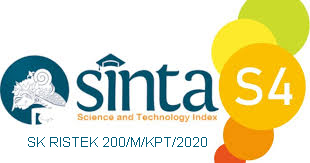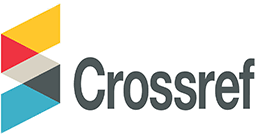Literacy Review Study on the Implementation of Convolutional Neural Network Architecture in Segmentation and Classification of Lung Medical Images
Abstract
Medical image processing has become an essential aspect of healthcare, enabling accurate disease diagnosis and monitoring through advanced technologies. One of the most widely used methods in this domain is the Convolutional Neural Network (CNN), which has demonstrated high effectiveness in segmentation and classification tasks, particularly for chest X-ray images used in diagnosing lung-related diseases. This study aims to evaluate and analyze various CNN architectures implemented in lung X-ray imaging through a Systematic Literature Review (SLR) approach. The research explores the application, accuracy, challenges, and future opportunities of CNN-based models such as VGG, ResNet, AlexNet, and GoogLeNet. A total of 15 relevant studies published between 2019 and 2023 were selected after applying rigorous inclusion and exclusion criteria. The findings indicate that CNN architectures significantly enhance the accuracy of lung disease detection and support both segmentation and classification tasks. However, challenges such as dataset variability, model generalization, and ethical implications remain. This review provides comprehensive insights into CNN applications in medical imaging, emphasizing their potential and highlighting areas for further research.
Keywords
Full Text:
PDFReferences
I. Pitas, “Digital image processing algorithms and applications,” A Wiley-Interscience publication. 2000.
M. Xu et al., “Segmentation of lung parenchyma in CT images using CNN trained with the clustering algorithm generated dataset,” Biomed. Eng. Online, 2019, doi: 10.1186/s12938-018-0619-9.
Y. Lu, X. Wu, P. Liu, H. Li, and W. Liu, “Rice disease identification method based on improved CNN-BiGRU,” Artif. Intell. Agric., 2023, doi: 10.1016/j.aiia.2023.08.005.
Q. X. Zhang, G. H. Lin, Y. M. Zhang, G. Xu, and J. J. Wang, “Wildland Forest Fire Smoke Detection Based on Faster R-CNN using Synthetic Smoke Images,” in Procedia Engineering, 2018. doi: 10.1016/j.proeng.2017.12.034.
Y. Singh et al., “The Role of Geometry in Convolutional Neural Networks for Medical Imaging,” Mayo Clin. Proc. Digit. Heal., 2023, doi: 10.1016/j.mcpdig.2023.08.006.
R. Chauhan, K. K. Ghanshala, and R. C. Joshi, “Convolutional Neural Network (CNN) for Image Detection and Recognition,” in ICSCCC 2018 - 1st International Conference on Secure Cyber Computing and Communications, 2018. doi: 10.1109/ICSCCC.2018.8703316.
N. IBRAHIM et al., “Klasifikasi Tingkat Kematangan Pucuk Daun Teh menggunakan Metode Convolutional Neural Network,” ELKOMIKA J. Tek. Energi Elektr. Tek. Telekomun. Tek. Elektron., 2022, doi: 10.26760/elkomika.v10i1.162.
W. Setiawan, “PERBANDINGAN ARSITEKTUR CONVOLUTIONAL NEURAL NETWORK UNTUK KLASIFIKASI FUNDUS,” J. Simantec, 2020, doi: 10.21107/simantec.v7i2.6551.
S. Hira, A. Bai, and S. Hira, “An automatic approach based on CNN architecture to detect Covid-19 disease from chest X-ray images,” Appl. Intell., 2021, doi: 10.1007/s10489-020-02010-w.
R. AGUSTINA, R. MAGDALENA, and N. K. C. PRATIWI, “Klasifikasi Kanker Kulit menggunakan Metode Convolutional Neural Network dengan Arsitektur VGG-16,” ELKOMIKA J. Tek. Energi Elektr. Tek. Telekomun. Tek. Elektron., 2022, doi: 10.26760/elkomika.v10i2.446.
S. Arvind, J. V. Tembhurne, T. Diwan, and P. Sahare, “Improvised light weight deep CNN based U-Net for the semantic segmentation of lungs from chest X-rays,” Results Eng., 2023, doi: 10.1016/j.rineng.2023.100929.
M. F. Aslan, “A robust semantic lung segmentation study for CNN-based COVID-19 diagnosis,” Chemom. Intell. Lab. Syst., 2022, doi: 10.1016/j.chemolab.2022.104695.
X. Chen, Q. Duan, R. Wu, and Z. Yang, “Segmentation of lung computed tomography images based on SegNet in the diagnosis of lung cancer,” J. Radiat. Res. Appl. Sci., 2021, doi: 10.1080/16878507.2021.1981753.
W. M. Salama and M. H. Aly, “Framework for COVID-19 Segmentation and Classification Based on Deep Learning of Computed Tomography Lung Images,” J. Electron. Sci. Technol., 2022, doi: 10.1016/j.jnlest.2022.100161.
W. Hastomo, E. Hadiyanto, and D. Sutarno, “Klasifikasi Covid-19 Chest X-Ray Dengan Tiga Arsitektur Cnn (Resnet-152, Inceptionresnet-V2, Mobilenet-V2),” Semin. Nas. Teknol. Inf. dan Komun. STI&K, vol. 5, no. 1, pp. 2581–2327, 2021.
S. M. Ashhar et al., “Comparison of deep learning convolutional neural network (CNN) architectures for CT lung cancer classification,” Int. J. Adv. Technol. Eng. Explor., 2021, doi: 10.19101/IJATEE.2020.S1762126.
H. Alshazly, C. Linse, M. Abdalla, E. Barth, and T. Martinetz, “COVID-Nets: deep CNN architectures for detecting COVID-19 using chest CT scans,” PeerJ Comput. Sci., 2021, doi: 10.7717/peerj-cs.655.
A. A. Kusmareni, A. Desiani, S. Yahdin, M. Saviera, A. I. Putri, and D. A. Zayanti, “Segmentasi Paru-Paru Pada Citra Thorax Dada Dengan Menggunakan Metode Cnn U-Net,” JSI J. Sist. Inf., vol. 14, no. 2, pp. 2666–2676, 2022, doi: 10.18495/jsi.v14i2.16771.
F. A. Hermawati and M. Imam Safii, “Sistem Deteksi Keganasan Kanker Paru-Paru pada CT Scan dengan Menggunakan Metode Mask Region-based Convolutional Neural Network (Mask R-CNN),” Konf. Nas. Ilmu Komput., no. August, pp. 193–197, 2021.
U. Khultsum, F. Sarasati, and G. Taufik, “Penerapan Metode Mobile-Net Untuk Klasifikasi Citra Penyakit Kanker Paru-Paru,” JURIKOM (Jurnal Ris. Komputer), 2022, doi: 10.30865/jurikom.v9i5.4918.
J. Yopento, E. Ernawati, and F. F. Coastera, “Identifikasi Pneumonia Pada Citra X-Ray Paru-Paru Menggunakan Metode Convolutional Neural Network (CNN) Berdasarkan Ekstraksi Fitur Sobel,” Rekursif J. Inform., 2022, doi: 10.33369/rekursif.v10i1.17247.
DOI: https://doi.org/10.31326/jisa.v8i1.2172
Refbacks
- There are currently no refbacks.
Copyright (c) 2025 Joko Riyono, Supriyadi, Christina Eni Pujiastuti, Sofia Debi Puspa, Aina Latifa Riyana Putri

This work is licensed under a Creative Commons Attribution-ShareAlike 4.0 International License.
JOURNAL IDENTITY
Journal Name: JISA (Jurnal Informatika dan Sains)
e-ISSN: 2614-8404, p-ISSN: 2776-3234
Publisher: Program Studi Teknik Informatika Universitas Trilogi
Publication Schedule: June and December
Language: English
APC: The Journal Charges Fees for Publishing
Indexing: EBSCO , DOAJ, Google Scholar, Arsip Relawan Jurnal Indonesia, Directory of Research Journals Indexing, Index Copernicus International, PKP Index, Science and Technology Index (SINTA, S4) , Garuda Index
OAI address: http://trilogi.ac.id/journal/ks/index.php/JISA/oai
Contact: jisa@trilogi.ac.id
Sponsored by: DOI – Digital Object Identifier Crossref, Universitas Trilogi
In Collaboration With: Indonesian Artificial Intelligent Ecosystem(IAIE), Relawan Jurnal Indonesia, Jurnal Teknologi dan Sistem Komputer (JTSiskom)
JISA (Jurnal Informatika dan Sains) is Published by Program Studi Teknik Informatika, Universitas Trilogi under Creative Commons Attribution-ShareAlike 4.0 International License.


















